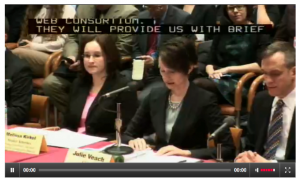A news report by: Stacey Alletto, Brigette S. Burnett, Lauren Hales and Hollie Hojek
At a nursing home in Bronzeville, state inspectors found a resident soaked in urine. At a nursing facility in Elmhurst, some patients lost dangerous amounts of weight because they weren’t fed properly.
And at an Oak Lawn nursing home, an elderly man wandered away on a winter night without anyone noticing. Two hours later, he was found face down in the cold. He was admitted to the hospital for hypothermia and subsequently died.
These are just some of the incidents that have occurred at Chicago-area “one-star” and “two-star” nursing homes.
The federal government started rating nursing facilities in 2008 on a star system, with one star the lowest ranking and five stars the highest. Of the 335 homes in the six-county Chicago area, 47 percent currently receive one or two stars.
While Illinois lawmakers this year passed legislation to improve nursing homes, the reforms focus primarily on care for young, mentally ill patients. Little attention has been paid to the geriatric population – the bulk of nursing home residents.
Recently, Columbia College Chicago journalism students fanned out across the region to detail conditions in one- and two-star nursing homes. Besides touring the facilities and interviewing nursing officials, the students reviewed several hundred state public health inspection reports from 2001 to 2010.
The picture that emerges is grim: Some residents have died of neglect while others have routinely experienced indignities.
At the one-star Renaissance at 87th Street nursing home on the South Side, inspectors found that a man in a wheelchair had urinated and defecated on himself, and the fluid was dripping in a puddle around him. Inspectors also learned that the man had not been bathed in days.
After a staffer finally washed him, he was left naked in a chair and had to ask an inspector to help him put on his pants.
Wendy Meltzer, executive director of Illinois Citizens for Better Care, said nursing homes often struggle with inadequate staffs.
“They don’t know what they’re doing or sometimes they really just don’t care,” she said. “But most of the time it’s because there just really aren’t enough people to take care of the residents.”
Some nursing home officials, such as Marty Aukstuolis, assistant administrator for Renaissance, said their low government ratings were unfair.
“We’re nowhere near perfect, and of course we can be better,” he said. “But I’ve seen and worked at worse facilities.”
The government’s star ratings can be found at www.medicare.gov/NHCompare, while many inspection reports are available at www.idph.state.il.us/webapp/LTCApp/ltc.jsp.
Here are snapshots of four of the area’s most troubled nursing homes:
In Bronzeville, new name can’t shake old problems
For years, the old Chevy Chase Nursing and Rehab Center was a name some people in historic Bronzeville associated with shoddy care. Today, the facility has a new name — Bronzeville Park Skilled Nursing and Living Center — and its administrator, Tony Prather, said the home is “totally different.”
But a tour of the facility and a review of inspection reports suggest otherwise.
For example, inspectors in 2007 noted “build-up of dirt, mold, fruit flies … broken or missing wall and floor tiles, loose hand rails, standing water and exposed electrical wires” in the shower and bathrooms.
Three years later, Prather acknowledged he doesn’t check the showers every day, adding: “We know we have a fruit fly issue, but we’re trying to fix it.”
Prather said all of the aging fixtures have been replaced and that his wife did some remodeling. Now, automatic sliding doors lead visitors through the facility’s renovated interior, where Bronzeville art dazzles the walls. The facility’s community areas showcase flat-screen televisions and an interactive sensory room called Glady’s Place for residents to reminisce.
Despite the improvements, an exposed cable cord welcomed a reporter into Bronzeville Park’s senior lounge area while the smell of urine lingered through the halls of the second floor.
One problem, Prather said, is that sometimes a staff member will remark, “That’s not my resident.” In 2003, a certified nursing assistant used those exact words after an inspector observed a patient soaked in urine, records show.
Prather said his response to such a statement is, “Does your check say Bronzeville Park room 323 bed 2 or does it say Bronzeville Park nursing?”
The federal government  rates the home one star, or “much below average.” The facility’s latest annual inspection report details how a resident fell 15 times in 2008 and four times the following year. The patient suffered from seizures and depression. Prather said the resident would not comply with rules, and so “what can you do? Because you can’t restrain the resident.”
rates the home one star, or “much below average.” The facility’s latest annual inspection report details how a resident fell 15 times in 2008 and four times the following year. The patient suffered from seizures and depression. Prather said the resident would not comply with rules, and so “what can you do? Because you can’t restrain the resident.”
One of the more troubling incidents occurred in 2003, when a resident wandered from the home. The resident had many previous elopement attempts and suffered from a cognitive disorder.
On his seventh attempt, records show, he left his unit on the third floor undetected and walked out of the facility and nearly eight miles to his wife’s home “wearing a yellow lady’s winter jacket” in 30-degree weather.
Prather said he understands why some people are hesitant to place loved-ones in nursing homes. He said people think “no one is going to take care of mom like you’re going to take care of mom.”
Left unchecked, man dies in cold
On a January night in 2004, a 75-year-old patient with a history of wandering went missing from ManorCare West Nursing and Rehab in Oak Lawn. Six staff members, five of whom were aware of the patient’s past behavior, saw him meandering around the nurses’ desk just prior to the incident.
But no action was taken, and two hours later he was found lying face-down on a residential street. The wind chill factor hovered below zero, and his body temperature was 88.3.
He died the next morning from bronchial asthma and cold weather exposure. A doctor in the county medical examiner’s office said it seemed the patient was exposed to the cold temperatures “for more than a few minutes and more like a few hours,” records show.
Inspectors found that four days prior to the death the man went toward the front door, and the electronic monitoring device he was wearing set off alarms. Though the man was wearing a monitor the night he disappeared, staffers said they did not hear alarms.
In response to the death, the nursing home told regulators it would do a better job monitoring patients.
(For Chicago Tribune coverage of the death)
According to the government’s ranking system, the 191-bed ManorCare West rates two stars, or “below average.” The home scored low in both staffing and health inspection findings.
ManorCare spokeswoman Julie Beckert said the rating “doesn’t take into account that centers like ManorCare take very high acuity patients, so our staffing is different. We have more therapists, therapy aides and nurse practitioners that are not accounted for in staffing.”
Another example of neglect at ManorCare occurred in 2006 when a 97-year-old woman developed sores that became infested with maggots. The woman had to have her leg removed at mid-thigh.
The most recent readily available inspection report, from August 2009, revealed poor communication between nurses and doctors. One patient’s health status was not recorded daily, and a doctor’s orders were not written down and followed. As a result, the patient was hospitalized and, according to the physician, “not doing well.”
Meltzer, the advocate for nursing residents, said many facilities are so poorly staffed that overwhelmed workers might quit caring.
“You either go someplace else where you can do good work or you shut yourself off emotionally,” she said.
At South Side home, neglect a recurring issue
When an 83-year-old man fell at the Renaissance at 87th Street facility last year, he was not immediately helped because several nursing aides said they did not see him.
A nurse who found the man called his doctor and was told to monitor him for 24 hours. He had a slight fever so she gave him Tylenol. A few hours later, records show, he slipped into unconsciousness and died the next day.
Assistant administrator Marty Aukstuolis said neglect is not tolerated and that two of the aides were let go. But he said falls occur among the elderly.
“You don’t want them to fall,” he said. “No one comes into work saying, ‘I want a patient to fall and hurt themselves today.’ ”
In a neglect case in 2008, a resident in a wheelchair had urinated and defecated on himself. When asked about this case, Aukstuolis said: “If someone is intentionally doing harm to a patient, like leaving a person in their waste like that, it’s not tolerated.”
He said “unfortunately” the inspector went into the patient’s room before a nurses’ aide did and found that the resident needed cleaning.
Aukstuolis said aides are required to check on patients every two hours. “We don’t have the kind of resources where we can have someone spend 24 hours a day with one patient,” he said. “I wish we could, but we don’t.”
In Renaissance’s most recent available inspection report, some residents hadn’t had their bandages changed while others weren’t being helped with meals.
“Honestly, I can say this is a good home,” Aukstuolis said. “I wouldn’t work here if I didn’t feel it was a good place to work.”
Supervision issues plague Elmhurst facility
At first glance, Lexington of Elmhurst appears to be a well-kept, pleasant nursing home. It offers group activities, pet birds, common areas to watch TV and movies, and opportunities for residents to get their hair done on Wednesday mornings.
But the government rates the 150-bed facility in suburban Elmhurst a one-star home. A recurring issue: the lack of supervision, particularly at mealtimes. In some cases, this has contributed to significant weight-loss because residents were not being fed adequately, records state.
In 2003, four patients dependent on staff for feeding lost weight. One evening, an inspector saw that the four residents were not fed until 40 minutes after dinner started and after other patients had completed their meals.
In 2007, inspectors noticed a strong odor in the dining hall, where residents were having lunch. This was brought to the attention of the administrator and the director of nursing. The following day, inspectors wrote, staff reviewed the condition of the residents’ clothing and cleaned their wheelchairs.
By 2008 dining issues still had not been resolved. An inspector saw a female resident trying to cut beef cutlet, and the food was sliding on her plate.
She was also trying to eat soup with a fork. But staff did not try to help her, records state.
Another woman was trying to eat gravy from a plate with her fingers. Again, staff did not help.
In response to this inspection, the facility vowed to assist residents during meals, records show.
Bed sores have also been an issue. In 2006, inspectors found sores on a resident who was dependent on nurses to move around. While two sores were present when the patient was admitted to the facility, a nurse told inspectors that the home was unaware of two new sores.
In an interview with a Columbia reporter, Lexington representatives said the home recently had a change of staff and could not comment on specific violations. But the manager on the memory care floor, Mychelle Walter, said the facility does an excellent job. “I’m proud of the people we work with,” she said.












Be First to Comment